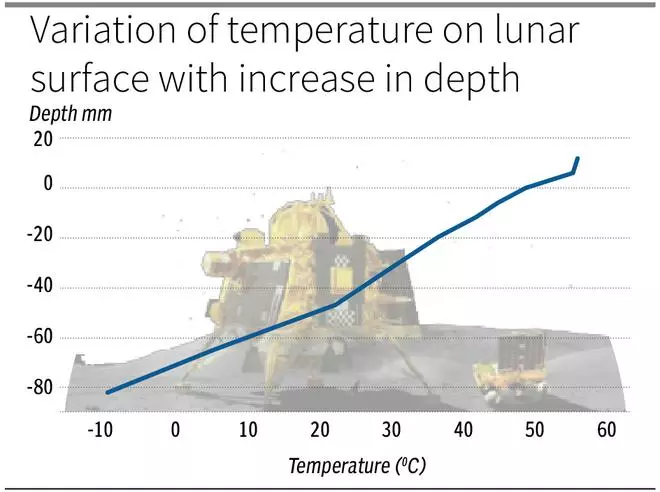An instrument on the Vikram lander has measured the temperature of the moon 10 cm below the surface and has come up with a revelation: there is a sharp temperature drop.
The graph shows that at a few millimetres above the surface the temperature is a little over 50 degrees C, but as you go down to 8 cm below the surface, it drops to minus 10 degrees C.
- Also read: All you need to know about Chandrayaan–3
The inference is that the moon does not hold the heat it receives from the sun, because there is no atmosphere to absorb it. The moon’s surface reflects everything back.
The Vikram lander, which majestically sits on the moon basking in the copious adulations from home, but it is not sitting quiet. The ‘Chandra’s Surface Thermo physical Experiment (ChaSTE)’, which is one of the four instruments onboard the Vikram, got active, first measuring the temperature of the lunar topsoil, and then sending a ‘temperature probe’ 10 cm below the surface.
Ten sensors
The probe is fitted with 10 individual temperature sensors. Together, they show the temperature variation as you go down.

“This is the first such profile for the lunar south pole,” ISRO tweeted, after releasing the graph. “Detailed observations are underway,” it said.
- Also read: Chandrayaan-3: After the landing
The ChaSTE was developed by the Space Physics Laboratory at the Vikram Sarabhai Space Center, Trivandrum in collaboration with the Physical Research Laboratory (PRL), Ahmedabad.
Now, the simple question is, why should one be bothered about the sub-surface temperature of the moon?
The moon’s subsoil temperature tells a lot. For example, it can hint at where water ice may be hiding. It can indicate what lies beneath — subsurface geological features such as lava tubes and impact craters. A temperature gradient can help assess the habitability of the moon and reveal how to design habitats. Furthermore, subsoil temperature variations can help figure out the moon’s thermal history.
This is only the beginning. There are four instruments on the Vikram lander and two more on the Pragyan rover. These six are sure to throw up bountiful data in the coming days, which will enhance mankind’s knowledge of the cosmos.




Comments
Comments have to be in English, and in full sentences. They cannot be abusive or personal. Please abide by our community guidelines for posting your comments.
We have migrated to a new commenting platform. If you are already a registered user of TheHindu Businessline and logged in, you may continue to engage with our articles. If you do not have an account please register and login to post comments. Users can access their older comments by logging into their accounts on Vuukle.